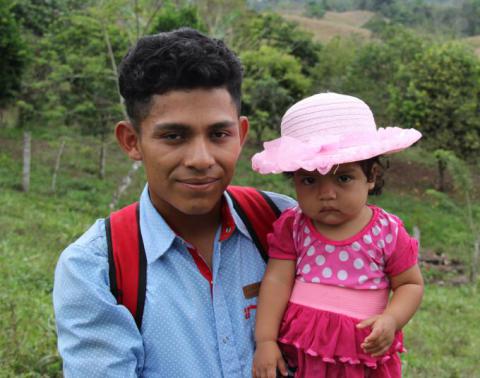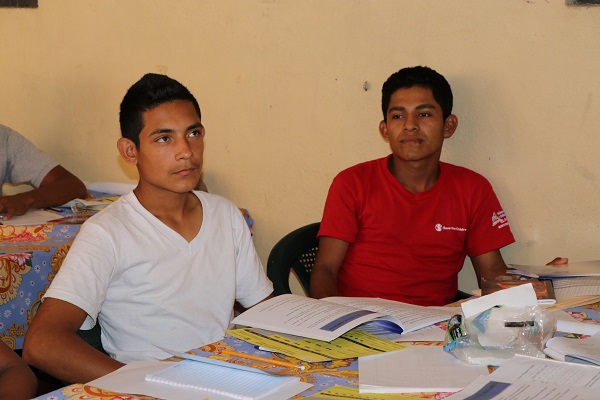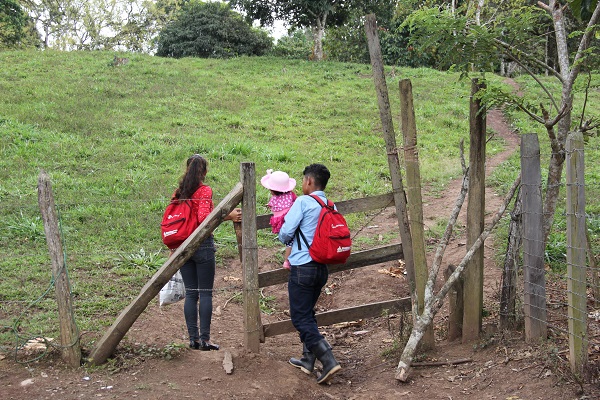 Nicaragua
Nicaragua
Languages
“I feel like a community leader”
It is midday in San José de Bocay, but today is not an ordinary day. It is not as quiet as normal and the streets are packed. The town is marking its patron saint’s day, so the local people are on holiday amid religious ceremonies and celebrations. Despite this, a group of community health workers (CHWs) is meeting in the “Ambrosio Mogoron” Health Center. Among them is 23-year-old Javier Antonio Palacios Centeno, who despite his young age already has over 10 years’ experience as a CHW.
Javier lives in the community of El Hormiguero in the municipality of San José de Bocay, department of Jinotega, about 270 km from the capital city of Managua. He started as a CHW at the age of 13 “when my cousin had to go away and couldn’t attend the weighing sessions.” Javier explains that “He sent me, and that’s how I started: weighing newborn babies up to the age of two. He asked me to help him and then took me to a Save the Children training session and they started to take me into account and I began to be fully involved in the work.”
Javier is a young man who talks deliberately and shyly. He is married with a two-year-old daughter and is recognized as a leader in his community. As he firmly states, “I feel like a community leader, because people consult me about health left, right and center.” Javier calls on his community and the authorities to support him in order to strengthen his leadership, stressing that “I expect the local authorities to help me be a leader, because a leader can’t do anything without support from the community and authorities.”
Tito Evelio Centeno, a teacher at the only school in El Hormiguero, confirms Javier’s recognition in the community. “I taught Javier from first to fourth grade,” he explains. “He had excellent conduct, very good learning and academic performance, and now that he’s serving the community working as a community health worker, his work is excellent because he’s maintained coordination with the teachers and all the mothers in the community.”
Recognition inside and outside of the community
Javier’s work is recognized by both the community and the municipal health authorities. “He’s an excellent community health worker who works on community case management (CCM),” explains Luis Ronaldo Garcia Chavarría, who is head of the Health Ministry’s Sector #9. “He’s an active, participatory CHW who does his work well, identifying all of the risk factors in relation to CCM, as well as giving his patients early quality care to provide his community with solutions. He’s been an essential pillar for the community network and even for the Ministry of Health (MINSA) in identifying primary health care risk factors.”
The recognition of Javier’s leadership is a result of the passion and dedication with which he works. He started as a community health worker in 2007 with the Health Ministry’s Community Health and Nutrition Programme (PROCOSAN), before in 2008 joining the Community Case Management Strategy, which has been promoted by Save the Children in Nicaragua since 2006. In 2007, MINSA allowed this strategy to be applied in the communities and starting in 2012 it became a ministerial norm, along with other community strategies related to health and nutrition.
When we ask Javier about the cases he attends to, he starts going over them: “Following up on babies and pregnant women after disease warnings are detected, particularly in relation to febrile conditions, diarrhea and pneumonia.” And he also gives us examples of cases and the different steps he takes when attending to a child. It’s obvious that he has a firm grasp of the MINSA care protocols.
“You know when you have to hurry,” Javier says. “One example with pneumonia is an age classification. A child under six months old has to take at least 50 breaths a minute, otherwise you have to call the ambulance. If the ambulance doesn’t come, we take them to Bocay on foot, which takes more or less seven hours. We carry them in a hammock, taking it in turns among a number of us.”
Luis Ronaldo has known Javier for five years, since he started working for the Health Ministry. At the time, Garcia was head of the “El Tigre” Health Post, which covers the community where Javier lives. As a result, he has witnessed Javier’s development as a community health worker. “He’s always exceeded himself in primary health care management,” Garcia recalls. “He’s been developing very well in the community and really makes an effort to provide quality and friendly health care in his community.”
Successfully working in remote communities
It takes about two hours by vehicle and seven on foot to reach the municipal capital of San José de Bocay from the community of El Hormiguero. A public transport truck passes through this community and other neighboring ones once a day, bound for the municipal capital. Javier’s house is about a 50-minute walk uphill from the truck station and the community lacks basic services (drinking water and electricity), but despite these limitations he says he feels happy in the place where he lives.
“Life is nice here in the community,” explains Javier, “because you can get on well with everyone. I’ve had support from everybody.” He sums up his life in very few words, telling us how he divides his time between working as a community health worker, working in the fields growing maize and beans, playing piano in the Catholic church, going to youth pastoral meetings, being with his family, and playing baseball.
The number of children he attends to in a week ranges from a single child to five a week, depending on the season. What he finds most rewarding is that “People don’t have to leave walking as a result of any case that arises in the community; now they can come to you and you can sort things out for them.”
No children have died in the community of El Hormiguero as the result of preventable causes for over eight years, and there have also not been any maternal deaths. According to Javier, this is because “the CCM strategy has come to the community. We receive guidance, talks and counselling on this strategy and every month, or every two months, we talk to the people in the community about cases of diarrhea and pneumonia.” The community health workers have a vital role in terms of child survival in Nicaragua’s rural communities, as their almost immediate intervention allows patients to be stabilized until they reach a health unit.
According to Carlos Jarquín, a Save the Children health technician in Jinotega, there have been no reported child deaths from preventable causes since the CCM strategy started to be implemented, something he says “is recognized by MINSA, asking us to intervene in more communities of San José de Bocay and Wiwilí, which are the department’s biggest municipalities.”
Javier coordinates the vaccination and deworming campaigns with the people from the Ministry, who “come to the community; the doctor or nurse based in the ‘El Tigre’ health post comes. Right now we’re going to ask them to visit, before the harder rains start.” The “El Tigre” health post is a two-hour walk from Javier’s house, but it is cut off from the community when the river rises too high.
Always looking to learn
The training processes that MINSA conducts both individually and with Save the Children have been important for him. “We’re always learning something new, more practical above all,” he says. “The last thing we learned is the campaign promoting “Every last child’.”
Six months ago, Javier was involved in the internships that Save the Children supported with MINSA, working for a week in the “Heroes and Martyrs of Ayapal” Primary Hospital in San José de Bocay. “It’s like a test of what we do here,” he tells us. “It involved presenting ourselves to the specialists. During that week we attended to children, but it was more practical. We learned how to handle newborn babies, which we’d never done before. They talked to us about how to provide health care to the children in our community, how to fill in the registry, the way we have to treat children, and how to keep a better control of the medicine.”
“I learned a lot during the internships,” Javier concludes, allowing a timid smile to break across his face. “And I practiced more with my mom, who was pregnant, with my little brother, and with my daughter who’s around two years old.”
Carlos Jarquín remembers Javier from the time he started, so he knows the whole process this young community health worker has been through, from applying the PROCOSAN programme, to the CCM, the internship, and receiving cellphones and first aid kits. “He got one of the best qualifications in the internship,” Carlos explains. “Evaluations were done every day and he stood out. He’s changing his reality; MINSA’s always calling him because they recognize his work.”
ITCs in community health
In 2016, Save the Children introduced technological innovations into its implementation, providing CHWs with 69 mobile phones that had an application connected to the Ministry of Health and Save the Children. This allows the CHWs to send them their real-time needs for medicines in their assigned first aid kits, enabling the health authorities to make timely interventions in this respect.
“It’s a joint system,” says Carlos Jarquin. “Save the Children provides the technological tools, which aren’t limited to the mobile phones, as MINSA has a tablet in each municipality that is linked up to the organization and the CHWs.”
Javier’s aunt, Mildred Centeno, tells us that her nephew is always looking for health information and often questions his cousin, Dr. Javier López Centeno, who is Mildred’s son. “He’s very active,” she explains. “He worries about the people there. Here in our home he doesn’t ask if there are any sick children, because my son’s a doctor, so he chats to my son about what he does.”
Javier finished primary school and wants to complete his studies, but the costs of travelling to San José de Bocay have hindered this. What he would really like to do, if possible, is become a doctor like his cousin.
His advice to new community health workers is to “Get inspired and strengthen themselves, because at the beginning you’re afraid and nervous and you don’t know what to do.” He stresses that “You accumulate experience in life because presenting yourself in a community, loving the community, is a responsibility. I’m talking to several youngsters, teaching them to learn to love this and get involved.”
It is very rare for CHWs like Javier to join during their adolescent years and then continue working, maintaining their commitment to the community, as their work is not paid. But serving his people has been Javier’s greatest conviction over the last 10 years.
Save the Children is currently working in 21 municipalities in western and central-northern Nicaragua through the community case management strategy. Thanks to 610 CHWs, we are reaching 244 rural communities that are over two hours away from the nearest health unit.


